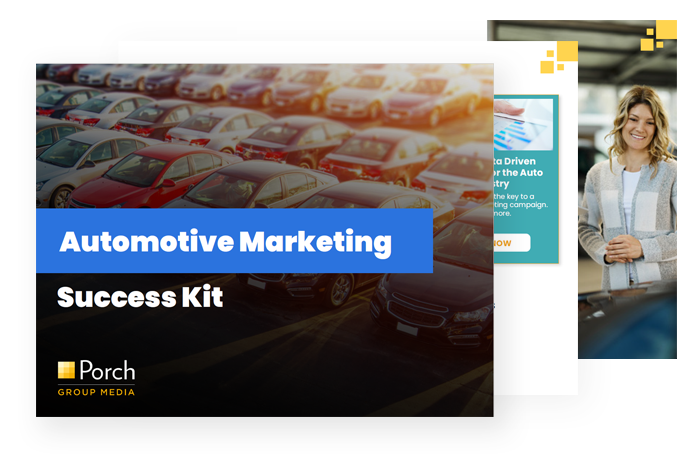The US Automotive industry is in the midst of robust spending on digital advertising and marketing. In a report by eMarketer, consistent double-digit growth in digital ad spending is forecasted for the auto industry through 2020.

Last year for the first time ever, advertisers spent more on display advertising than on search engine marketing. This shift was especially evident in the auto industry in which digital ad spend increased by 22 percent.
Automotive marketers know that more shoppers are turning to the internet to do their research. Instead of visiting multiple dealerships to compare brands, shoppers can now compare brands, models, colors, and prices on multiple online sites. Auto advertisers can now reach much larger audiences on auto shopping sites and other digital destinations through display advertising.

Personalizing the Digital Experience
Before purchasing a vehicle, the typical consumer considers multiple brands and is in market for approximately 90-120 days. Instead of waiting until a shopper is close to purchasing, automotive marketers have an opportunity to provide rich digital experiences and engagement throughout the journey. For example, a consumer may visit an automotive site and then later see car ads for that specific make and model show up in their Facebook feeds.

A connected customer experience however cannot happen without data. Automotive marketers must put the data they have at hand to good use. They also have access to a lot of third-party data that can be used to gain a richer understanding of shoppers and in turn, provide a more intuitive experience.
A customized audience can also be created to target auto consumers by segments such as motorcycle enthusiasts or car enthusiasts. Ads can be served specifically to consumers who have indicated they are in market to purchase, and these consumers can even be further segmented by types of car they are in market for such as SUV, truck, small car, luxury vehicle, or SUV. Or perhaps consider targeting consumers with specific vehicle budget ranges.
Target Consumers with Facebook Ads
A study by comScore found that Facebook ads increase vehicle consideration and also decreases consideration of other competitors. According to the study, actions after seeing Facebook ads include:
- 37% increase in dealership visits
- 17% increase to dealership and automotive brand sites
- 11% increase in brand search activity
- 14% decrease in competitive model searches
- 3% decrease in competitive brand searches

Facebook has become much more sophisticated in the way consumers can be targeted with ads. In the “Automotive” behavioral category alone, consumers can be targeted by the following areas:
- New Vehicle Buyers (“near market” thinking about buying in the next year)
- New Vehicle Shoppers (“in market” looking to within next 180 days)
- Owners
- Purchase Type
- Used Vehicle Buyers (in the market to buy now)
- Motorcycle
Other popular segments include:
- Vehicle Type (car, SUV, truck, van)
- Make
- Model
- Year
- Financial (i.e. median home value and credit score range)
- Segments such as vehicle history data and garage data
Connected TV Advertising (CTV)
The TV viewing landscape is experiencing rapid change with the rise of streaming and connected TV. Control has shifted into the hands of consumers who have more programming consumption choices than ever before. This year, we will continue to see more internet-based TV platforms entering the market and more consumers cutting the cord on traditional TV viewership.

With consumers now scattered among more devices and screens, automotive brands must adopt highly targeted and data-driven strategies to reach their target audiences. By leveraging more sophisticated ways of blending first and third-party data, brands can hone in on audiences with targeted advertising using advanced segmentation techniques and household-based targeting.
Automotive Purchase Intender Audiences
Porch Group Media’s automotive purchase-intender audiences allow brands to target in-market consumers who are actively shopping for cars.
Examples of key audiences include:
- Auto Purchase Intender: Households that are currently in the market to buy a vehicle in the next 6 months. These are qualified, intent-to-purchase consumers who have recently visited an auto dealer lot.
- Auto Aftermarket Purchase Intender: Households that are currently in the market to buy after-market auto parts such as tires, cleaning supplies, motor oil, seat covers, tires, GPS vehicle devices, and more.
- Auto Service Buyer: Households that are likely to bring their vehicle to a dealership for routine maintenance such as tune-ups, oil changes, tire rotation, and other preventative maintenance services.
- Auto Purchaser Intenders Broken into Brand Categories: Households that have a high propensity to shop for and purchase vehicles within specific brand categories including full range brands, luxury brands, and economy brands.
Porch Group Media’s automotive purchase-intender audiences can be accessed through all major Demand Side Platforms (DSPs) including Oracle’s Data Cloud, Nielsen Marketing Cloud, Exelate, LiveRamp’s Data Store, Lotame, Google, MediaMath, The Trade Desk, Turn, and more.
Car buying is no longer a localized activity thanks to the advent of the Internet and digital channels. Consumers do their research and may sift through hundreds of listings before they find a brand and dealership that captures their attention, regardless of location. With the availability of so much data today, automotive marketers have unprecedented access to numerous data sets in order to pinpoint and target the right audiences specific to their brand.






